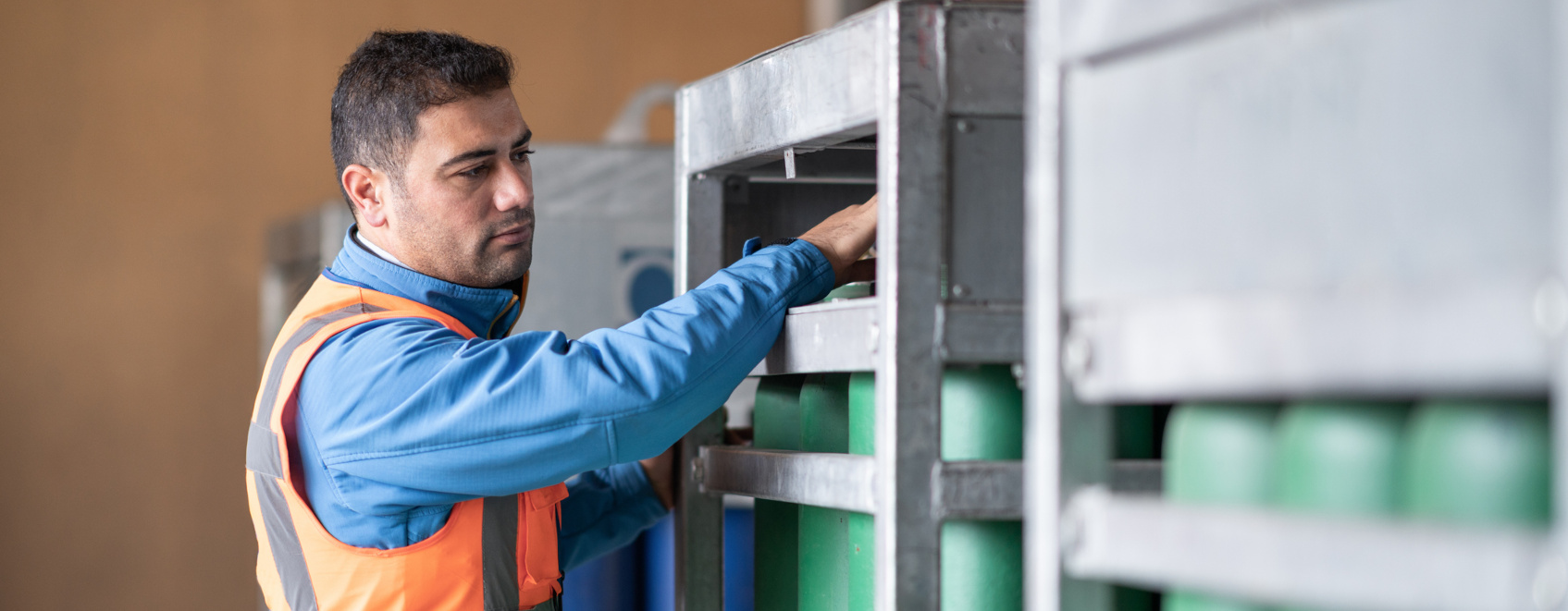Using and storing flammable liquids safely in your business

When it comes to protecting your small business, good fire management practices can go a long way. For many industrial and service businesses, that includes the proper storage and handling of flammable and combustible liquids.
Flammable and combustible liquids have their own specific technical definitions, but they generally refer to liquids that ignite easily and burn quickly, making it more likely that a fire will spread.
These liquids are found in a wide range of businesses due to the fact that they make excellent cleaners, solvents and lubricants, but they can also pose a major hazard to life and property if employees aren’t storing them properly.
So what are flammable and combustible liquids, and how should you be handling and storing them within your business? Below, UFG Insurance’s risk control consultants offer their best guidance for working with these volatile liquids and how you can best protect your business.
Flammable v. combustible liquids: the basics
When creating a fire prevention strategy for flammable and combustible liquids, you first have to understand what exactly you’re working with. The terms flammable and combustible liquids are often used interchangeably in the field, but they technically represent two different classes of volatile liquids, grouped by flash point.
A liquid’s flash point is the minimum temperature at which it forms enough vapor above its surface to ignite if exposed to an ignition source. Liquids with a lower flash point ignite easier because they produce ignitable vapors even at normal temperatures that you might find in any business.
Liquids with flash points below 100°F are considered flammable; liquids with a flash point above 100°F are combustible, as defined by the National Fire Protection Association’s (NFPA) 30 code standard.
For example, gasoline is a flammable liquid, with a flash point of -40°F, while motor oil is combustible, with a flash point of more than 300°F.
Classes of flammable and combustible liquids
Flammable liquids are further divided into three classes that include their boiling point.
- Class IA: liquids with a flash point below 73°F and a boiling point below 100°F. Examples: acetaldehyde, ethyl ether and cyclohexane.
- Class IB: liquids with a flash point below 73°F and a boiling point at or above 100°F. Examples: acetone, benzene and toluene.
- Class IC: liquids with a flash point at or above 73°F and below 100°F. Examples: hydrazine, styrene and turpentine.
- Class II: liquids having flashpoints at or above 100°F and below 140°F, except any mixture having components with flashpoints of 200°F or higher, the volume of which make up 99% or more of the mixture’s total volume. Examples: acetic acid, naphtha and stoddard solvent.
- Class III: liquids having flashpoints at or above 140°F. These are subdivided into two subclasses:
- Class IIIA: liquids having flashpoints at or above 140°F and below 200°F, except any mixture having components with flashpoints of 200°F (93.3oC) or higher, the volume of which make up 99% or more of the mixture’s total volume. Examples: cyclohexanol, formic acid and nitrobenzene.
- Class IIIB: liquids having flashpoints at or above 200°F. Examples: formalin and picric acid.
Both flammable and combustible liquids are capable of producing ignitable vapors under the right setting, so they require special storage and handling procedures, especially in settings where sources of ignition are common.
Note that when a combustible liquid is heated for use to within 30°F of its flash point, it must be handled in accordance with the requirements for the next lower class of liquids.
Storing flammable liquids in your business
The federal Occupational Safety and Health Administration (OSHA), along with many states and local governments, have enforceable requirements for the safe handling and storage of flammable and combustible liquids, so you should always start there when designing storage solutions. Many of these rules are based on the NFPA 30 standard, which you can find here.
In general, flammable and combustible liquids must be stored in closed containers that are in good condition and properly labeled.
In industrial applications, liquid storage containers, known as IBCs, are usually large shipping vessels with capacities ranging from 100 to nearly 1,000 gallons. NFPA 30 stipulates that flammable liquids should never be placed in plastic IBCs, although composite designs and metal tanks are acceptable for this purpose. Combustible liquids can be stored in plastic tanks, but they must be listed, or certified, to last in a fire for at least 20 minutes.
In smaller commercial applications, flammable liquids can be stored in approved safety cans, but they must also be stored in a storage cabinet specifically designed for this application. No more than 60 gallons of flammable liquids can be stored in a single cabinet, and there are other specific distance, wiring and ventilation requirements within storage rooms for flammable and combustible liquids.
Note that commercially available domestic refrigerators cannot be used to store flammable and combustible liquids, due to the wealth of ignition sources inside. OSHA requires specific “spark-free” refrigerators designed specifically for this use for liquids that must be kept cool.
You can read more from OSHA about these storage guidelines here (PDF).
Remember that a liquid’s flammability or combustibility class is not the only factor you should consider when determining your safe storage needs. You also need to consider:
- Ignition temperature.
- Explosive limits (LEL or UEL).
- Vapor pressure.
- Specific gravity.
- Vapor density.
UFG’s risk control consultants can help you think through the complexities and details that come with designing a comprehensive fire prevention plan for flammable and combustible liquids, and put it into practice. UFG insurance agents and policyholders, contact our risk control staff at 800-828-2705 or email us at riskcontrol@unitedfiregroup.com for assistance.

